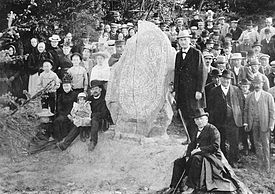- Odendisa Runestone
-
Runestone 
Name Odendisa Runestone Rundata ID Vs 24 Country Sweden Region Västmanland City/Village Fläckebo Parish Produced c. 1050 Runemaster Red-Balli
Text - NativeSee article Text - English See article Other resources Runestones - Runic alphabet
Runology - Runestone stylesThe Odendisa Runestone (Swedish: Odendisastenen), sometimes called the Hassmyra Runestone, is a Viking Age runestone erected at Hassmyra, Västmanland, Sweden, that is a memorial to a woman.
Contents
Description
The runic text carved on the serpent of the Odendisa Runestone contains a poem in fornyrðislag and is one of few runestones raised for a woman, and the only one in Sweden with a verse commemorating a woman.[1]
- KumbR hifrøya
- til Hasvimyra
- æigi bætri,
- þan byi raðr.
- There will come
- to Hassmyra
- no better housewife,
- who arranges the estate.
Note that she was the one "who arranges the estate." This runic inscription is a reference to the centrality of women in early medieval Scandinavian ("Viking") society where the woman was in charge of the estates and the homesteads and wore the keys of the buildings.[2]
The theophoric name Odendisa (Old Norse: Óðindísa), which means "Goddess of Odin," is a unique name and is not known from any other source. In addition, the name of her husband is very rare.
The Odendisa Runestone was carved by Red-Balli, a famous runemaster who was active in the region around lake Mälaren in the second half of the 11th century. The name Red-Balli is indicated by the runes roþbalir, which is not part of the main text carved on the serpent but starts a separate outer text band at the lower left of the inscription. This stone is classified as being carved in runestone style Pr4, also known as the Urnes style. This runestone style is characterized by slim and stylized animals that are interwoven into tight patterns. The animal heads are typically seen in profile with slender almond-shaped eyes and upwardly curled appendages on the noses and the necks.
In modern times, the stone is mentioned as early as the 1660s. According to tradition, a farmer discovered the runestone while he plowed the field. A few years later it cracked into two parts, but it was mended in 1900 and raised anew at its present location.
Inscription
Transliteration of the runes into Latin characters
- buonti × kuþr × hulmkoetr × lit × resa × ufteR × oþintisu × kunu × seno × kumbr × hifrya × til × hasuimura × iki betr × þon × byi raþr roþbalir × risti × runi × þisa × sikmuntaR × uaR ... sestR × kuþ[3]
Transcription into Old Norse
- Boandi goðr Holmgautr let ræisa æftiR Oðindisu, kunu sina. KumbR hifrøya til Hasvimyra æigi bætri, þan byi raðr. Rauð-BalliR risti runiR þessaR. SigmundaR vaR [Oðindisa] systiR goð.[3]
Translation in English
- The good husbandman Holmgautr had (the stone) raised in memory of Óðindísa, his wife. There will come to Hassmyra no better housewife, who arranges the estate. Red-Balli carved these runes. Óðindísa was a good sister to Sigmundr.[3]
Notes
- ^ Jesch, Judith (1991). Women in the Viking Age. Woodbridge: Boydell Press. p. 65. ISBN 978-0-85115-360-5. http://books.google.com/books?id=9xpNRpI9zFoC&printsec=frontcover&source=gbs_navlinks_s#v=onepage&q=&f=false.
- ^ Gräslund, Anna-Sofie (2001). "The Position of Iron-Age Scandanavian Women: Evidence from the Graves and Runestones". In Arnold, Bettina; Wicker, Nancy L. Gender and the Archaeology of Death. Cumnor Hill (Oxford): AltaMira Press. pp. 84–86. ISBN 0-7591-0137-X. http://books.google.com/books?id=6hVz6RzCkJcC&printsec=frontcover&source=gbs_navlinks_s#v=onepage&q=&f=false.
- ^ a b c Project Samnordisk Runtextdatabas Svensk - Rundata entry for Vs 24.
References
Categories:- Runestones in Västmanland
- Runestones raised in memory of women
- Old Norse poetry
Wikimedia Foundation. 2010.

